It can be difficult to understand a person we are in relationship with especially when sometimes we don’t even understand ourselves. Why do we feel good about ourselves one moment and bad another? Why does a person change their attitude towards us from one day to the next? Each human is a complex creature whose behavior is driven by emotion, beliefs, point of view, and how much coffee they had that morning.
Combine that with another person who is driven by different emotions, beliefs, point of view, and how much they drank last night and we have an opportunity for emotional drama and chaos. Some call it a roller coaster of emotion while others are calling for relationship help.
If your relationship dynamics have emotional drama what do you do to fix it? Where can you get a relationship help manual so you can begin to understand the dynamics?
As I sought to understand relationship drama (so I could avoid it) I discovered several foundational elements that affect all relationships. It didn’t matter whether it was a love relationship, family relationship or a work relationship all of them were principally driven by six different images. When I understood these six images I could not only make sense of other people’s behavior and emotional reactions, but also my own. For the first time I understood the reasons why I got into an emotionally dramatic relationship and why I stayed as long as I did. When I became aware of these unseen forces I knew where to make the changes to avoid the roller coaster of emotion that I had been on.
The original concept for this material comes from a talk by my mentor don Miguel Ruiz. But it wasn’t’t until a vision three years later in the New Mexico desert that I fully realized the power these six illusions have in creating a matrix of emotional drama in peoples’ lives.
To get an overview with examples look at the diagrams and listen to the audio clips of how these six images drive our emotions, behaviors, and decisions in relationships. The audio clips are blue buttons. For more detail read the description below.
It is through awareness of how we trap ourselves that we can begin to get out of the drama. The most amazing potential offered by this awareness is the possibility of living outside the illusions of the Relationship Matrix. That experience is lived authentically in the heart with the emotion of love and respect.
False images of ourselves and each other form the basis for emotional reactions
If we want to make permanent meaningful changes in our relationship dynamics, we should address the real cause – the images we carry in our minds of ourselves, and each other.
We don’t have just one self-image – we have many, and our emotional behaviors in relationships, and how we feel about ourselves, arise from these images. This gets even more complicated when we consider that the other person in the relationship has behaviors and agreements driven by their self images. These images exist as belief structures in the mind and are often difficult to see in the beginning, but as you develop awareness, it becomes easier.
In order to see these images, start by noticing your thinking, internal dialogue, and what you say about yourself and other people. These comments are clues to the images that lie below the surface of normal awareness. I’ve added some diagrams and woven a story to give you a visual picture of the structure between two people. For this example I’ll use a relationship between a man and a woman.
 |
The layers of illusions that create emotional drama dynamics in a relationship.
Let’s begin with the man’s side of the story. Enter Phil. Phil will play the man’s role in the relationship. We must first understand that the Phil doesn’t come alone. What comes with him is a set of beliefs, stories, and images in his mind. That set of beliefs includes images of who Phil believes he is. We could say that every story about him self has an image associated with it.
  |
Some images Phil has fall into the category of “not good enough.” They include failure, loser, not smart enough, not good looking enough, not rich enough, not powerful enough, not good enough in bed, not ______ (fill in the blank) enough. These images can be found in any story Phil has about himself where he compares himself to someone else and doesn’t measure up, or doesn’t feel that he measures up to his own expectations. These beliefs are what create an image of low self esteem that Phil wants to keep hidden. It’s not who Phil really is, just a false Hidden Image that he sometimes believes he is.
We call it Hidden because it’s generally the aspects he doesn’t want anyone else to see. Often it is associated with the emotions of unworthiness, powerlessness, shame, and guilt. When Phil is in this belief paradigm he often looks at things from a Victim point of view.
But Phil comes with other self images also. He has a long list of what he is “supposed to be.” This is his inventory collected over the years of all the things that he should do or be to be “perfect,” or “good enough.” When Phil thinks and believes of himself as a success, winner, handsome, smart, hero, kind of guy he creates these images in his mind. His beliefs about what he “should be” may contain images something like this.
 |
These images are what Phil would “like to be” or believes he “should be”. Often he may really feel he is meeting his expectations. The projected image is what Phil would like others to see him as. When he meets someone new, or someone important to him, he puts his best image forward. Let’s call it his Image of Perfection, and it is what his Inner Judge in his mind holds as the standard.
These are his images of “success” and “winner.” When Phil doesn’t believe he is “good enough,” it is because he doesn’t feel he meets these standards in his mind. This often results in low self-esteem, low confidence, and a feeling of inadequacy. The result is that Phil feels like one of the “not good enough” hidden images in his mind. The emotions Phil feels are usually the result of comparing himself to the Hidden Image or the Projected Perfect Image. The image he believes he fits at the time determines how he feels about himself.
Not only does Phil feel like the character image he believes at the time, but he looks at the world around him from that viewpoint as well, when he holds that belief. Phil’s point of view shifts to the Image he believes in at the time. For example, when Phil has failed at something, he feels like a failure. But he also looks at the world through the eyes of a failure. We could call this a Victim point of view. From a Victim/Failure perspective even his successes are meaningless and unimportant – there is always some inadequacy in his best accomplishments.
When he believes he is a successful winner, his point of view shifts to see things from that Projected Image of Perfection. From this point of view he doesn’t look at his failings and see a failure. He sees someone that was building character to become a success. All interpretations from this point of view defend the Perfect Projected Image.
Phil’s emotional state is formed from a combination of Belief, Self Image, and Point of View. Since these essentially come as a package, changing one requires changing all three.
Just for the record, a person might hold two different images of himself at the same time, and therefore have two different points of view and experience two different emotional states at the same time. When this is happening we may have two different stories fighting it out in our mind. The first story insists that we did something wrong. The second story defends our image and points out how we were right. Both sides of the conflict have fabricated false self images, which mean that neither version represents our authentic self.
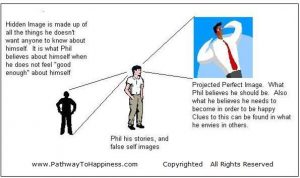 |
Neither of these Images are Phil. Phil is not the Failure or the Success. He is the person that creates and believes, or doesn’t believe, these images in his mind. He is the one that gives them power or does not give them power to define who he is.
This is a story of relationship drama and it doesn’t stop here.
There is something completely unexpected that happens, now — a woman shows up on the scene. Let’s call her Francis. Francis sees Phil, meets him, and…
 |
in meeting him she makes her assessment, adds appropriate descriptive words to her mental image, and in a short time, she forms an impression of him. She creates an image in her mind of who Phil is. Is it an accurate image? No. It’s a false image of Phil according to how she sees him. Where is the image? It is in Francis’ mind. When Francis thinks of Phil she sees her version of him. Her version is false. It is made up, imagined, not real, artificial. I call that version Faux Phil.
To Francis Faux Phil may look like…
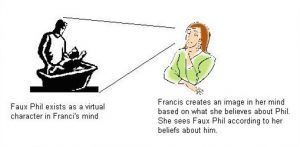
Whenever Francis describes Phil or talks about him to her friends, she is actually describing Faux Phil. Other people see Phil differently. They have their own Faux Phil images according to their interpretation. No two people have exactly the same Faux Phil image, including Phil himself.
Who is Francis?
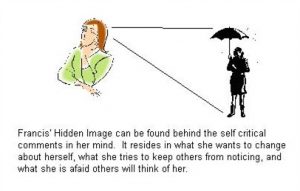 |
We should note here that Francis probably didn’t show up on the scene without some beliefs about her self as well. Her beliefs about herself are found in the stories she has in her mind. In areas where she feels inadequate or not “good enough” she has created images in her mind about who she is. Francis has aspects of herself that she doesn’t want others to see. Francis’ Hidden Image is found in what she doesn’t want others to know about her.
These self images reside within her internal dialogue about not being smart enough, what her body looks like, not being pretty enough, or doing well enough financially or professionally. These stories are predominately told from the Victim point of view.
To have our attention in these beliefs and this point of view without awareness is emotionally painful.
In order to compensate for her “not good enough” image, and the feelings it creates, Francis imagines herself as a beautiful successful winner. She works extra hard to be her “best.” It’s what she really “wants,” and what she really believes she should be. It’s also how she would like other people to see her. She projects all the attributes of the Perfect Image to the world. Francis might believe that if she could be “Perfect” then she would be happy. She tries hard to be “Perfect” because she wants to be happy. Unfortunately, she has multiple images in her mind of what “Perfect” is, depending on the situation.
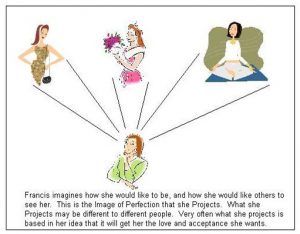 |
At times she feels like the person she tries to be. At other times she struggles with the conflicting self-images of “not good enough.” And at times she may even feel like she doesn’t really know who she is, because she doesn’t’ believe in any of the images that her imagination offers.
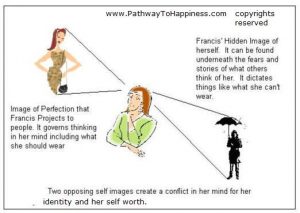 |
It’s very likely that these different self-images may create some stories in her mind when she meets a man like Phil. Francis wants to make a good impression. She wants him to see her best side, or should we say her best False Projected Image. This might make for all sorts of stress about what to wear and what her hair looks like. The fear part is about hiding the Hidden Image.
But I digress. This is a boy meets girl story, and it must continue.
When Phil meets Francis he doesn’t see into her mind. He doesn’t see Francis the way Francis sees her images. He doesn’t see her Projected Image. He might not even see that she is projecting. Phil forms an impression of Francis based on his own likes and dislikes. He may like things about her that she doesn’t believe she has. He may like things about Francis that she would rather keep hidden. Maybe he doesn’t notice anything about Francis that needs hiding. Phil has his own criteria for liking and not liking someone that are separate from Francis’ criteria.
Phil forms an impression of Francis in his mind based on the way he sees her from his own point of view. Phil creates an image in his mind of who Francis is. That image exists only in his mind.
 |
Phil creates his own Faux Francis. To Phil Faux Francis may look like this…
So what if they met at the gym.
How Phil sees Francis has nothing to do with how anybody else sees her. It doesn’t even have to match up with how Francis sees her self.
Are you following all this?
By now, you may think you need a playbook to keep track of the players in the field of relationship imagination. Individually one of these elements makes a lot of sense. But what happens when all the False Images are going on at once? Let me put it all in one place for you. A typical relationship is between two people, and their six False Images that influence their behaviors and emotions.
The false image illusions in the imagination may look something like this.
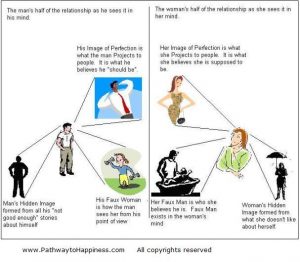 |
Understanding Relationships using the Six False Images
It might be difficult to relate this diagram to real life scenarios. I provide an example as to how these six images affect our emotions, behaviors, and choices in relationships. They form the underlying core to problems and emotional drama that we experience in relationship.
In Summary these are the images of Phil in the relationship:
- Phil has an image of himself that relates to low self esteem and insecurity. He wants to keep this hidden.
- Phil projects an image of confidence in which he tries to make a good impression and stress his strengths. This is his Image of Perfection that he projects.
- Faux Phil. This is how Francis sees Phil. Francis has her own understanding of who Phil is in her life and who he isn’t. This is different from how Phil sees himself.
These are the images of Francis in the relationship:
- Francis has an image of her self associated with her insecurities. This image is imbedded in her stories of self criticism and how “she thinks” others might judge her. She wants to keep these issues hidden to avoid judgment and rejection.
- Francis projects an image of perfection of all her best features and strengths. The belief is that this will get her acceptance and love. This is the image she projects.
- Faux Francis. This is how Phil actually sees Francis. Phil forms his impression of Francis based on what he likes and dislikes about her. This is different from what Francis likes and dislikes about her self-images.
This makes for six false images operating in their relationship. Each one plays a part in how their emotions are generated. Each one influences or drives them to certain behaviors and emotional reactions. And all of the six are imaginary.
A simple example of the emotional dynamics this might create:
Phil and Francis are driving to an event together. Phil feels he should drive because this is what a man is “supposed” to do (Projected Image). Phil proposes that he do the driving.
Francis is insecure in her Hidden Image about her sense of direction and getting lost. Francis interprets Phil’s proposal to mean that Phil doesn’t want her to drive because of her inadequacy. (Not Phil’s reasoning at all.) Francis Victim is offended by Phil’s offer. (Hidden Image Dynamic) She doesn’t say anything because she wants to project that it is no big deal. (Projected Image to cover up the Hidden Image.)
Phil ends up doing the driving. In his mind she (Faux Francis) is thankful to not be burdened. The real Francis feels insulted by Faux Phil.
Phil ends up getting lost on the way to the event. In his mind he feels like a failure and judges himself as “stupid” for making the wrong turn. (Hidden Image belief with a Victim point of view.)
Francis still feels inadequate from Phil’s comment. Francis uses the opportunity to jump into a superior role of being right (her Projected Image) and criticizes Phil about being lost. Telling a story where she is right is a way to get out of her “not good enough” feeling. For a moment in her imagination she feels superior to Phil.
Because of a strong Image of Perfection of what he should be, Phil believes her criticism. His Victim does the interpretation that she is right. In his mind, her comment reinforces his belief that he is “not good enough.” Phil feels more hurt because she now sees him as “stupid” as well. This also reinforces the belief that he is failing to meet his Image of Perfection.
Francis reflects on her comment to Phil and concludes that it was uncalled for. She feels like a failure for not living up to her own Image of Perfection. She specifically judges herself for the criticizing comment and feels guilty. (Hidden Image Victim point of view is reinforced).
She also assumes that Phil is judging her for the comment. The assumption that Phil is judging her is taking place in her imagination, where it is actually Faux Phil. She is imagining that Faux Phil is judging her, even though the real Phil isn’t judging her at all. The real Phil is in his Victim point of view, as he interprets that she is right for calling him stupid.
Francis and Phil have made assumptions about what the other thinks, and their assumptions are played out by their Faux Character projections in their own minds. They are both wrong in their assumptions, but having real emotional reactions based on them. They do not see that their emotions are being created by their belief in their False Images of themselves.
The chain reaction in the relationship can continue. Their stories and emotions end up getting bounced around the Six False Images like a pin ball against electric bumpers. This is just a small example of how the False Self-Images are at the core of the emotional dynamics.
What is the way out of this emotional dynamic of False Images?
This type of emotional drama can continue in our own relationships until we realize one very important thing — these images are all made up! They are fictional. We are reacting to the movie in our imagination. The only power behind these images and their stories is the belief we give them. It is only because we believe these stories and images that we react emotionally. When we don’t believe in these False Images, we eliminate the emotional reactions.
It is important to note that it is more than just the belief and the image that makes for this dynamic. Integral to this dynamic is the point of view. The Judge essentially sees things from the Image of Perfection point of view. The Victim sees things from the Hidden Image point of view*. If we are to change the dynamic of our relationships, it is not enough to change our beliefs. We will also have to shift our point of view out of the Judge and Victim.
When we change our point of view and no longer believe in the images and the stories, we can eliminate all the emotional drama in our relationships. Without these False Images driving our reactions we can easily change our behaviors and our emotional reactions.
When we dissolve the False Images of ourselves we become authentic. We no longer reject ourselves based on a Hidden Image. We accept ourselves just the way we are. We don’t try to be that Image of Perfection in the imagination. We don’t need to be that False Image in order to find ourselves worthy of love.
When the False Images dissolve our mind is no longer split into different images of what we are and what we “should” be. Without this conflict in the mind we become whole again and recover our Emotional Integrity.
When we are authentic and live our relationships with awareness we don’t make false assumptions about the other person. We don’t expect them to act according to our Faux Character. Without those expectations we are never disappointed or angry with them for being who they are. We see them the way they are and we respect and accept them the way they are. Our love for them is unconditional because we don’t expect them to fit our image.
By the same token their love for us is not based on an image of who they think we are. Because their love is unconditional we can be completely free to be ourselves. A relationship that is authentic becomes a place where you can love with no expectations, and you are loved with no conditions.
To gain the awareness so that you can exit the relationship matrix of drama consider the Self Mastery Course. It will show you how to stay out of the illusion game of relationships. The sessions teach you how to identify the the roles and behaviors of drama and break the beliefs in the false images that drive them. The Relationship Course is a separate series for identifying specific emotional belief patterns that create drama and practices to change them.
*This is somewhat simplified but gives a general idea.
